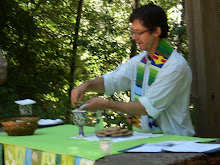Then I began to think about the official companion relationship that exists between my Diocese of Northern California and the Episcopal Diocese of Honduras. I'd met Bishop Allen of Honduras and the Rev. Olga Barrera when they attended our diocesan convention perhaps six years ago. I also had heard over the years from my clergy colleagues Ed Howell and Andrea Baker about their experiences there. When I let my Bishop, Barry Beisner, Andrea McMillin, the Canon to the Ordinary know that I was thinking about maybe working a visit to Honduras into my sabbatical plans they responded very enthusiastically. They informed me that Bishop Allen was going to be attending our convention again in November 2016, and promised to introduce me to him.
I did indeed get to chat with Bishop Allen at the convention. I told him I was thinking of going to Honduras during my sabbatical, and gave me a brief summary of the different kinds of work going on in the diocese and his message to me was, essentially, "Yes, do come. We'll be happy to welcome you; we have a place you can stay in San Pedro Sula, and from there you can go wherever you want." I felt sufficiently encouraged by our talk to begin planning in earnest to include Honduras in my sabbatical plans. Taking into account my family's various work, school, and vacation schedules I put some approximate dates on the calendar, and roughed out an itinerary that would include two weeks of Spanish-language school in Guatemala with my family, mixed in with some sight-seeing and vacation, followed by three weeks of solo travel, visiting the Episcopal Diocese of Honduras.
What form that visit ought to take was still unclear to me; I spoke with Andrea Baker, who had been a missionary for a year, assisting Rev. Olga Barrera at the Holy Spirit Bilingual School in Tela, and she encouraged me to spend my three weeks there. Ed Howell described for me his more free-ranging experience, going all over the country on his motorcycle, staying in the homes of diocesan clergy, or sometimes in hotels. My confusion about what to do while I was there stemmed in part from not knowing how our diocesan companion relationship between Northern California and Honduras works, or how my visit might help develop it.
In January I received an email from the Bishop of Honduras, forwarded on to the seven regional deans of our diocese by Bishop Beisner, of which I am one. It included a request that someone represent Northern California at the annual convention of the Diocese of Honduras in late May. I offered to be that representative, thinking that an introduction to the diocese in that capacity might help better understand the companion relationship, and plan my sabbatical visit accordingly. (I also liked the idea of doing a little reconnaissance before arriving sight unseen with my wife and daughter.). As it turned out, the convention was also attended by Bishop Greg Brewer of the Diocese of Central Florida. Central Florida has had a companion relationship with Honduras for over 25 years and a member of the Honduras Commission of the diocese accompanied the bishop.
This
highly developed and institutionalized form of companionship is unusual. With some time on my hands back in San Pedro after the convention, I did some looking into the websites of other dioceses of the Episcopal Church listed on the Diocese of Honduras website as having a relationship with them. Of the ten or so listed I found evidence of a diocesan-level commitment on three or four. What seems more common is that a handful of people within a diocese, often in a single town or congregation will have a continuing commitment to a particular locale, or project in Honduras.
Now that I have been here for two weeks and have had a first-hand look, it appears that this is how it works in Northern California. The relationship established by Olga Barrera, Connie Sanchez, Bishop Allen, and other Hondurans who have visited us, and by Kent McNair, Ed Howell, Andrea Baker, and
others who have visited them, has resulted most recently in a particular connection to Holy Spirit Bilingual School in Tela.
 |
| First day of classes, Holy Spirit, Tela |
relationship with Honduras will grow by the proliferation of direct contacts between the people of our two dioceses. I believe that it is by encouraging these contacts, through exchanges such as the one that Faith Church is planning, short- and long-term mission trips, and the like, that relationships will be forged that grow into alliances , with a transformative impact in Honduras and Northwrn California. A further benefit of expanding our involvement in Honduras would be the opportunity to work in partnership with mission-minded Episcopalians from other dioceses,many of whicom represent a more "conservative" and "evangelical" strain wthin the Anglican Communion. There is important work of reconciliation for us to do there, which will contribute to the spiritual growth of all concerned.



 u
u




